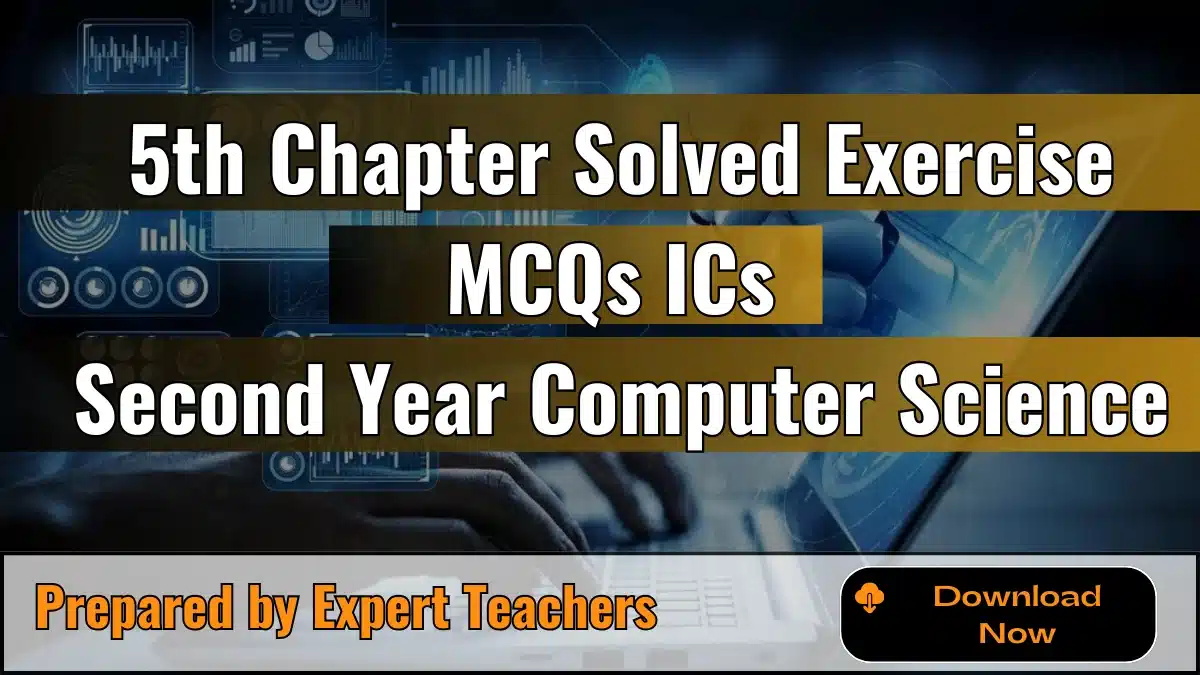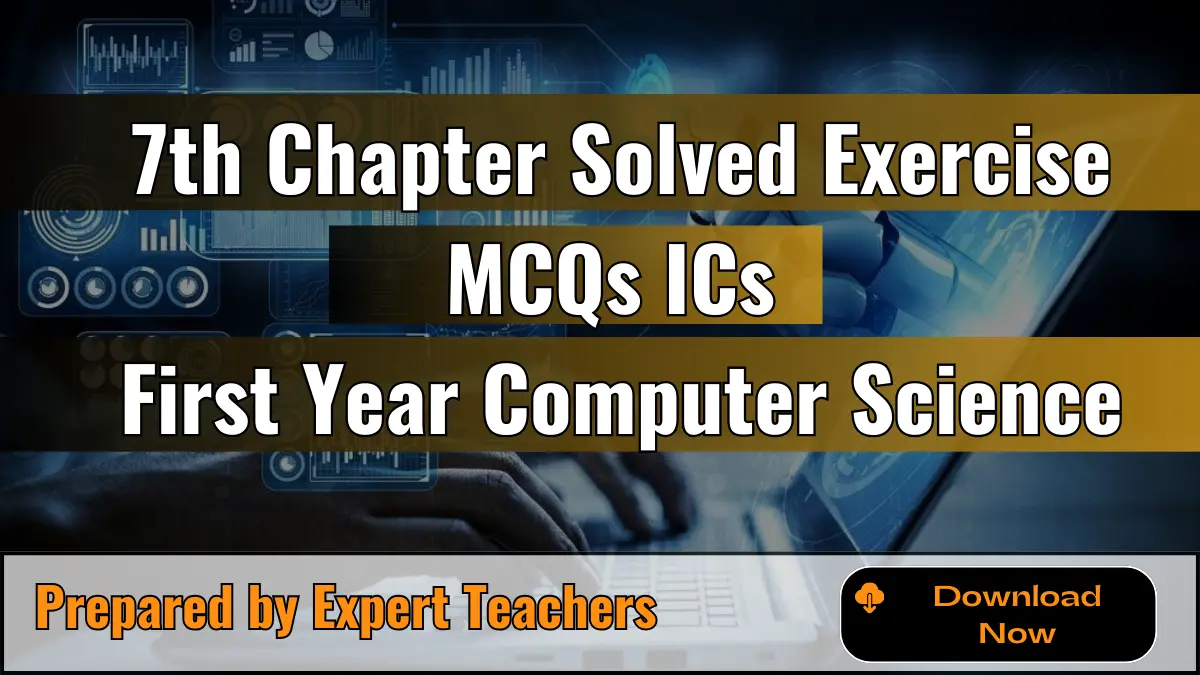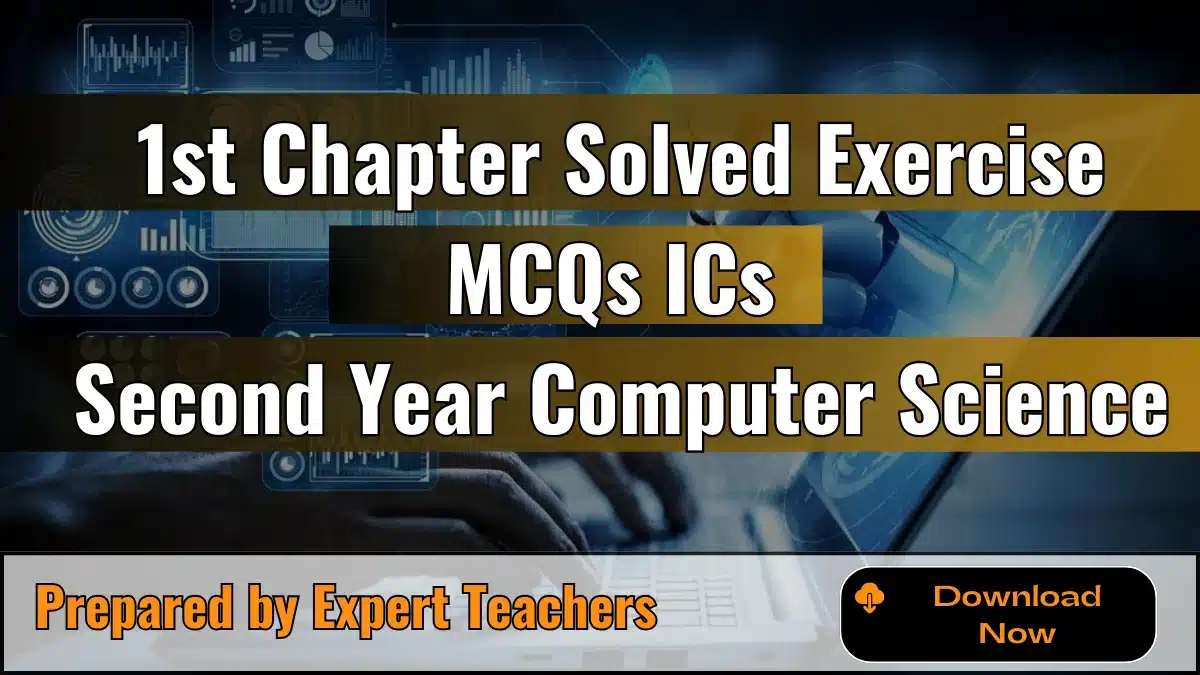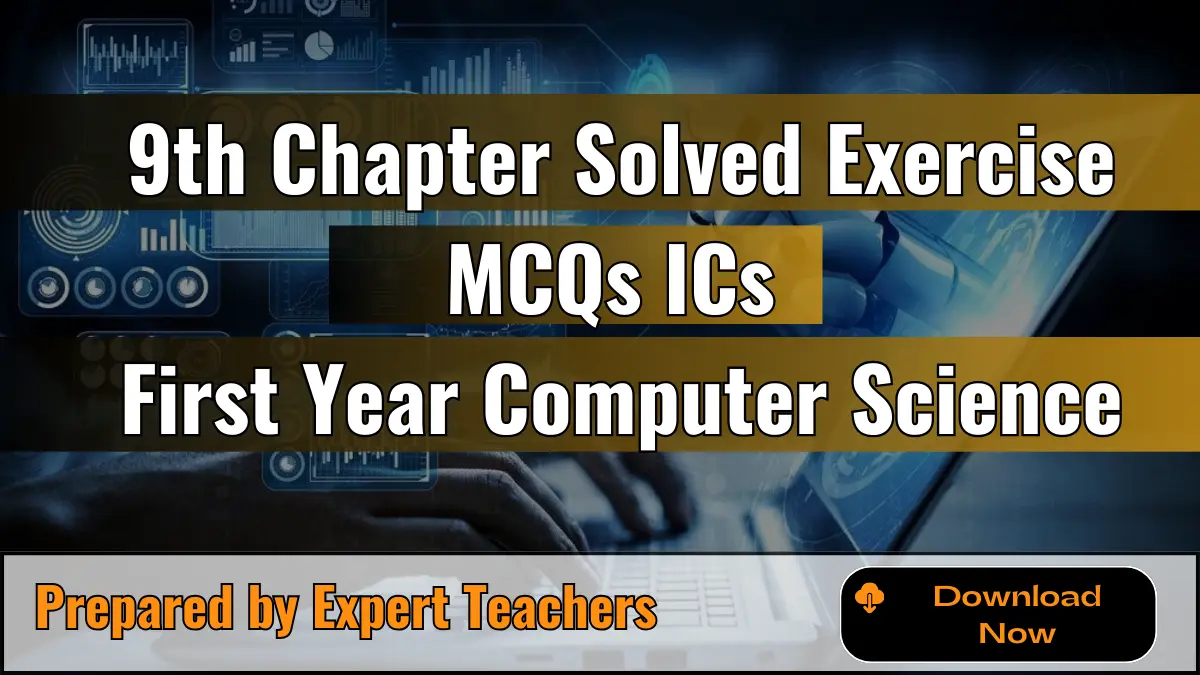1st Year Computer Chapter 1 MCQs With Answer
If you’re searching for 1st Year Computer Chapter 1 MCQs with answers, you’re in the right place. This collection includes important and repeated MCQs from Chapter 1 – basic of information technology. It’s perfect for quick test preparation, board exams, and class assessments. Whether you need the 1st Year Computer Chapter 1 MCQs PDF, want important MCQs for 2024, or just need accurate answers for practice, this is a helpful resource. You can also use it for offline study or download it later for free.
First Chapter Solved Exercise MCQs of ICS First Year Computer Science offers a collection of multiple-choice questions with answers, for ICS students.
First chapter solved Excercise MCQs with explanation
Here are solved excercise mcqs of chapter 1 basic of information technology:
1. The name for the screen clarity
(a) Resolution
(b) Discrete
(c) Pixel
(d) LCD
Explanation: Resolution refers to the number of pixels in an image, determining its clarity and detail.
2. Another word for pointer:
(a) Monochrome
(b) Pixel
(c) Cursor
(d) None of the above
Explanation: A cursor is a pointer that indicates the position on a screen where the user can interact with the computer.
3. A device used for optical-character recognition is a:
(a) Wand reader
(b) Cursor
(d) MICR reader
Explanation: Enables a computer to rapidly read and record numbers or other information from printed documents, such as a personal check.
4. Imaging uses what device to input data:
(a) scanner
(b) icon
(c) bar code reader
(d) tablet
Explanation: A scanner is used to input images or documents into a computer.
5. An ink-jet printer is an example of a(n)
(a) Laser printer
(b) Impact printer
(c) COM printer
(d) Non-impact printer
Explanation: An ink-jet printer is a type of non-impact printer that sprays ink onto paper to create an image.
6. Soft copy refer to:
(a) Screen output
(b) Peripheral devices
(c) OCR
(d) None of the above.
Explanation: Soft copy refers to data that is displayed on a screen, as opposed to hard copy that is printed.
7. Smallest unit of memory is:
(a) Byte
(b) Bit
(c) Character
(d) Word
Explanation: A bit is the smallest unit of memory, representing a single binary digit (0 or 1).
8. The printer which can print one complete line at a time is:
(a) Dot matrix printer
(b) Daisy wheel printer
(c) Laser printer
(d) Line printer
Explanation: A line printer can print an entire line of text at once, making it faster than printers that print character by character.
9. The microphone converts the sound into:
(a) Mechanical signals
(b) Electrical signal
(c) Computer file
(d) Software
Explanation: A microphone converts sound waves into electrical signals that can be processed by a computer.
10. An input device, which is used for playing computer games:
(a) Light Pen
(b) Mouse
(c) Joy Stick
(d) Scanner
Explanation: A joystick is a common input device used for controlling games, especially those that involve movement or direction.
1st Year Computer Chapter 1 MCQs With Answer
Here are solved mcqs of chapter 1 basic of information technology:
1. A collection of raw facts and figures is called:
(a) Procedure
(b) Information
(c) Processing
(d) Data
Explanation: Data refers to unprocessed facts and figures that have not been organized or given context.
2. A computer’s main function is to:
(a) Convert information to storage
(b) Convert data into information
(c) Display data
(d) Create data from information
Explanation: The primary function of a computer is to process raw data and transform it into meaningful information.
3. Which operation is not performed by a computer?
(a) Inputting
(b) Processing
(c) Controlling
(d) Understanding
Explanation: While computers can process information and make decisions based on algorithms, they do not possess genuine understanding or consciousness.
4. Multimedia can include the use of:
(a) Text
(b) Animation
(c) Voice
(d) All
Explanation: Multimedia refers to content that combines different forms of media, such as text, audio, images, video, and animation.
5. Data processing is also known as:
(a) Knowledge
(b) Computing
(c) Procedure
(d) Merging
Explanation: Data processing is the systematic execution of operations upon data to provide useful information; this is also known as computing.
6. The modern revolution in information technology can be termed as:
(a) Computer revolution
(b) Information revolution
(c) Communications revolution
(d) All
Explanation: The advancements in computers, information, and communication technologies have collectively led to a significant transformation, often referred to as the information revolution.
7. Information technology is a combination of:
(a) Computing and mechanical technology
(b) Computing and electrical technology
(c) Computing and mechatronics technology
(d) Computing and communication technology
Explanation: Information technology integrates computing technologies with communication technologies to manage and process information effectively.
8. The computing and communication technologies are combined for:
(a) Data sequencing
(b) Data routing
(c) Searching data
(d) Data communication
Explanation: Combining computing and communication technologies enables the transmission and exchange of data between different systems and locations, which is known as data communication.
9. What is the difference between hardware and software?
(a) Hardware is tangible but software is intangible
(b) Hardware is metal but software is plastic
(c) Hardware is permanent but software is temporary
(d) Hardware is reliable but software is unreliable
Explanation: Hardware refers to the physical components of a computer system that you can touch, while software consists of the intangible instructions and programs that tell the hardware what to do.
10. Hardware is best described as:
(a) Physical parts
(b) Printed copy file
(c) Logical part
(d) Program
Explanation: Hardware encompasses the physical and tangible components of a computer system.
11. The electronic circuits of a computer system are called a(n):
(a) Software
(b) Hardware
(c) Firmware
(d) Shareware
Explanation: The physical electronic components and circuits that make up a computer system are collectively known as hardware.
12. A computer is a combination of:
(a) Software
(b) Hardware
(c) Both a and b
(d) Knowledge
Explanation: A functional computer system requires both hardware (the physical components) and software (the instructions that run on the hardware) to operate.
13. The devices used to enter data or instructions into a computer include:
(a) Keyboard
(b) Mouse
(c) Microphone
(d) All
Explanation: Keyboard, mouse, and microphone are all examples of input devices that allow users to provide data and instructions to a computer.
14. Which of the following is NOT an input device?
(a) Keyboard
(b) Mouse
(c) Microphone
(d) Speaker
Explanation: A speaker is an output device that produces sound from the computer. Keyboard, mouse, and microphone are used to input data.
15. The hardware component that permanently holds data and programs is called:
(a) Primary storage
(b) CPU
(c) Secondary storage
(d) Output
Explanation: Secondary storage devices, such as hard disks and SSDs, are used for the long-term storage of data and programs, even when the computer is turned off.
16. The hardware device that temporarily holds data and programs is called:
(a) Primary storage
(b) CPU
(c) Secondary storage
(d) Output
Explanation: Primary storage, also known as RAM (Random Access Memory), is used to temporarily hold the data and programs that the CPU is actively using.
17. The electronic circuit that executes computer instructions is called a(n):
(a) Monitor
(b) Hard disk
(c) Keyboard
(d) CPU
Explanation: The Central Processing Unit (CPU) is the core of the computer that fetches, decodes, and executes instructions.
18. Which of the following is NOT a secondary storage device?
(a) Tape
(b) Hard disk
(c) Compact Disk
(d) RAM
Explanation: RAM (Random Access Memory) is primary storage, used for temporary data access by the CPU. Tape, hard disk, and compact disk are secondary storage devices for long-term data retention.
19. CPU is an example of:
(a) Software
(b) Language
(c) Hardware
(d) Program
Explanation: The Central Processing Unit (CPU) is a physical electronic component and therefore classified as hardware.
20. CPU stands for:
(a) Central Processing Unit
(b) Central Product Unit
(c) Computing Program Usage
(d) Central Programming Unit
Explanation: CPU is the abbreviation for Central Processing Unit, which is the main processing unit of a computer.
21. Additional data and programs not being used by the CPU are stored in:
(a) Secondary storage
(b) Input devices
(c) Output devices
(d) CPU
Explanation: Secondary storage devices are used to store data and programs that are not currently being actively processed by the CPU.
22. Step-by-step instructions that run the computer is called:
(a) Hardware
(b) Procedure
(c) Calculation
(d) Software
Explanation: Software consists of sets of instructions, or programs, that tell the computer hardware what to do and how to perform tasks.
23. Printers and monitors are common forms of:
(a) Input devices
(b) Output devices
(c) Storage devices
(d) Processing devices
Explanation: Printers produce hard copies of information, and monitors display visual output, making them output devices.
24. Another name for main memory is:
(a) Secondary memory
(b) Permanent memory
(c) Tape Storage
(d) Primary storage
Explanation: Main memory, where the computer actively stores data and instructions for the CPU, is also known as primary storage or RAM.
25. A major category of software is:
(a) Application and design
(b) Application and system
(c) System and design
(d) System and development
Explanation: Software is broadly categorized into two main types: system software (which manages the computer’s hardware and provides a platform for application software) and application software (which is designed to perform specific tasks for users).







Leave a Reply